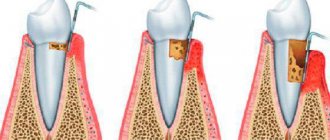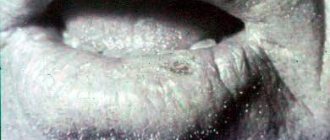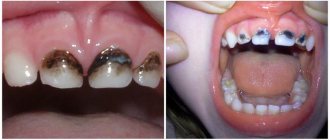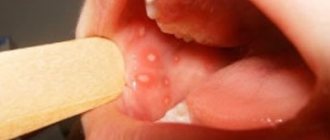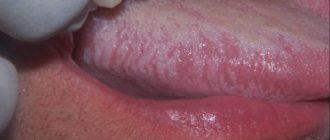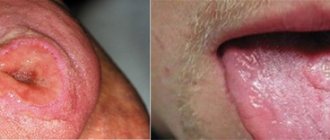Causes of diseases of the oral mucosa
Diseases of the oral mucosa occur throughout life in an average of 5-10% of the population.
Their cause may be:
- Traumatic damage to the tissues of the oral cavity and other traumatic effects (chemical, thermal, etc.) with the development of traumatic erosion, ulcers, leukoplakia or leukokeratosis (keratinization of an area of the mucous membrane capable of malignant degeneration).
- Infectious diseases that affect the oral mucosa due to the penetration of viruses, spirochetes, bacteria, and fungi.
Quite often, the occurrence of pathological changes in the oral mucosa is associated with disruption of the functioning of various organs and systems of the body: allergies, dysfunction of the cardiovascular system, gastrointestinal tract, endocrine disorders, systemic connective tissue diseases, blood diseases, dermatoses, tuberculosis, AIDS and some other conditions. It is often quite difficult to identify the true cause of pathology of the oral mucosa - a lot of experience, high professionalism, and the ability not only to carefully collect information, but also to interpret it correctly and draw appropriate conclusions are required. Experienced medical dentists will quickly understand the intricacies of the existing manifestations of the disease in relation to a specific patient, determine the cause of the disorder and prescribe highly effective treatment.
Generalist
When a patient turns to dental treatment specialists, the first step is to be examined by a dental therapist. Sometimes he also carries out a set of medical procedures, after which the help of other specialists is no longer required. The therapist first carefully examines the oral cavity and, based on the results of this examination, makes a preliminary diagnosis. Quite often, in order to clarify the situation as much as possible, this doctor writes the patient a referral to an X-ray room, where the current condition of the teeth can be studied in maximum detail.
If the diagnosis requires tooth filling, the dentist-therapist can perform this operation independently, without the intervention of other specialists, having first expanded the cavity that has arisen in the tissues due to caries and carried out antiseptic measures. If there is a serious illness, as well as if complications develop after treatment, the patient is referred to more specialized specialists.
Sokolova Svetlana Igorevna
Dentist therapist
More details
Korotkikh Tatyana Vitalievna
dentist therapist
More details
The main manifestations of diseases of the oral mucosa
There is a common name for inflammatory diseases of the oral mucosa - stomatitis. When the pathological process is localized on the tongue, they talk about glossitis, on the gums - about gingivitis, on the lips - about cheilitis. A characteristic manifestation of stomatitis is the appearance on the oral mucosa of foci of redness, blisters, erosions (afts) or ulcers covered with plaque. These lesions are most often detected on the mucous membrane of the cheeks, floor of the mouth, hard palate, and tip of the tongue. Often there is pain at the location of erosions and ulcers, enlargement of nearby lymph nodes, and sometimes an increase in body temperature. The average duration of the disease is 7-14 days. Stomatitis can recur with decreased immunity, poor diet, hypovitaminosis, infectious diseases, and exacerbations are more common in spring and autumn.
Causes and symptoms of periostitis
Symptoms of periostitis include swelling of the gums and face, suppuration, fever, and severe pain. The severity of dental flux manifestations depends on the form and severity of the disease. Swelling and asymmetry of facial contours depend on the location of the inflammation. With periostitis of the upper jaw, swelling of the upper lip, cheek and infraorbital area occurs. With periostitis of the lower jaw, swelling can be observed in the lower part of the face.
The causes of flux can be:
- failure to comply with hygiene rules;
- diseased or untreated teeth;
- consequences of complex tooth extraction;
- jaw injuries;
- infectious and inflammatory processes in the body;
- weakened immunity.
Diagnosis of oral diseases
Diagnosis of stomatitis and other diseases of the oral cavity is based on a thorough clinical examination of the patient by a dentist, which makes it possible to determine the stage of the pathological process and its prevalence, and the presence of a general reaction of the body to inflammation. It is very important to establish the true cause of the disease (trauma, infection, allergy, pathology of internal organs, hypovitaminosis, etc.), because the effectiveness of treatment and the absence of exacerbations in the future will depend on this. To do this, in a medical clinic, when recurrent stomatitis is detected, if necessary, a thorough additional examination is carried out with the involvement of relevant specialists - an allergist-immunologist, gastroenterologist, hematologist, endocrinologist, and laboratory and instrumental studies are performed.
Orthopedist
If the help of a therapist and periodontist did not produce results and the tooth could not be saved, it becomes necessary to install a prosthesis. This is what orthopedists do. At the first stage, their task is to obtain an impression of the tooth. Based on the results obtained, the dental technician makes a prosthesis. After this, the orthopedist first performs the so-called fitting, and then the final installation of the artificial tooth. There are many different options for prosthetics, from installing crowns to using removable jaws.
Konychev Evgeniy Alexandrovich
orthopedic dentist
More details
Turovets Alexander Igorevich
orthopedic dentist
More details
Treatment of diseases of the oral mucosa
- Etiotropic and pathogenetic therapy aimed at eliminating the cause of the disease (antiviral, antibacterial therapy for the infectious nature of stomatitis, glossitis, cheilitis, vitamin therapy for hypovitaminosis, treatment of the underlying disease that caused the appearance of a pathological process on the oral mucosa);
- Local treatment aimed at eliminating local traumatic factors, the main symptoms of the disease and the rapid healing of existing erosions and ulcers;
- A general strengthening treatment that stimulates the body's defenses.
An early visit to a dentist when identifying the first signs of pathology in the oral mucosa is the key to a speedy recovery!
Periodontist
The teeth in the oral cavity are surrounded by soft tissue. They are in a rather vulnerable position and can suffer from various diseases. Periodontists are specialists who primarily deal with this problem, as well as the condition of the mucous membrane. In particular, such doctors, when tartar or other deposits appear above or below the gum, remove these tumors. When treating, periodontists often use so-called applications, applying medications directly to the area affected by the disease.
Kravets Olga Yurievna
Dentist, periodontist
More details
Orlova Elena Lvovna
dentist, periodontist
More details
Features of the treatment of dental periostitis
To treat tooth flux, conservative and surgical methods are used. The choice of treatment method depends on the causes and degree of neglect of the disease.
The conservative method (without surgery) is used:
- at the initial stage;
- caused by weak immunity;
- due to other inflammations in the body.
For non-surgical treatment of flux, anti-inflammatory and antibacterial drugs and physiotherapy are used. The tooth is not removed, but the gum is cut in the area of swelling and drainage is installed.
In the case of purulent inflammation associated with dental diseases (odontogenic periostitis), or when conservative treatment is ineffective, surgical intervention is used.
Gastritis (gastroduodenitis)
This is one of the most common gastrointestinal pathologies, often occurring in both adults and children. With gastritis, due to changes in secretion, the acidity of gastric juice increases, and since all organs of the digestive system are directly connected to each other, such acidity cannot but affect the health of the oral cavity.
Dental symptoms of this disease include pallor and swelling of the mucous membranes, hypertrophy of the tongue papillae, dry lips, gingivitis, bad breath and sour taste.
Chronic gastroduodenitis is characterized by mild forms of stomatitis and gingivitis.
, herpes on the lips.
In both cases, disturbances in the production of saliva occur, which most directly affects the acid-base balance of the oral cavity and the intensity of bacterial growth: with a lack of saliva, the risk of carious and periodontal diseases
.
Treatment:
as a rule, individual, aimed at normalizing gastric secretion, increasing the protective properties of the mucous membrane of the stomach and oral cavity.
Dental treatment may include taking a course of antibiotic drugs (as recommended by a doctor), treatment of gingivitis and caries
, enhanced
oral hygiene
using special toothpastes to strengthen the gums and
professional oral hygiene
performed at least once every six months.
What diseases does a periodontist treat?
The area of expertise of a periodontist includes the treatment of gum diseases that have developed in periodontal tissues. The most common pathologies:
- Gingivitis is an inflammatory process of the periodontal soft tissues that occurs without disruption of the periodontal ligaments.
Only the gums are involved in the pathology. The first signs of the disease are bleeding and pain in the tissues surrounding the teeth. The pathology can occur in an acute form, which is also characterized by swelling, hyperemia of the mucous membrane, and itching. The chronic course of gingivitis causes virtually no discomfort, so a person is in no hurry to see a periodontist. Despite the asymptomatic course, the inflammatory process gradually progresses, complications arise - ulcerative-necrotic lesions, gum hypertrophy, detachment of mucosal areas, and others appear. The main cause of gingivitis is insufficient oral hygiene, which leads to the proliferation of bacteria. The periodontist usually prescribes conservative treatment, including removing plaque from teeth, using antiseptics, and antibiotics. - Periodontitis. Inflammatory periodontal disease, predominantly of an infectious nature. With periodontitis, destruction of the dentogingival ligaments occurs, and destruction of bone tissue develops. As the disease progresses, teeth begin to loosen and fall out. The disease is classified as polyetiological, since various reasons can lead to its development. Most often, the pathology develops due to the accumulation of bacterial plaque. In addition, periodontitis can occur due to poor heredity or gum injury. It often accompanies diabetes mellitus and is detected in hormonal disorders and other pathologies. A periodontist dentist, examining the mouth and jaw area, identifies the presence of periodontal pockets, bleeding, redness, swelling of the mucous membranes, and a heavy odor from the mouth.
- cavities. There is plaque on the teeth. Pus may be discharged from periodontal pockets. There is an exposure of the cervical zones of the segments, displacement of the teeth in the row, and their loosening. Treatment in the early stages is conservative, later - invasive.
- Periodontal disease. Non-inflammatory disease of periodontal tissues, characterized by a chronic course. The pathogenesis is based on circulatory dysfunction in the vessels supplying the periodontium. Violation of tissue trophism leads to the development of atrophic processes in the gum and bone tissues. Other causes of periodontal disease: malocclusion, smoking, decreased local immunity, hormonal imbalance, disruption of periodontal innervation, etc. The clinical picture of periodontal disease depends on the stage of the disease. Main symptoms: gum recession, pallor of the mucous membranes, increased spaces between units, their loosening. Bleeding gums are not typical for periodontal disease.
Treatment is aimed at strengthening the periodontium with the help of hygienic measures, drug therapy, and physiotherapy. If the degree is significant, the periodontist will suggest the surgeon
logical, orthopedic correction.
Stages of surgical treatment of flux:
- anesthesia (usually local);
- opening the focus of suppuration (gum incision);
- removal of pus;
- drainage (installation of drainage to ensure the outflow of inflammatory fluid);
- X-ray (to determine the cause of periostitis);
- removal of a diseased tooth or drug treatment.
In addition, for acute purulent periostitis, antibiotics, physiotherapy and painkillers are usually prescribed. Treating periostitis with antibiotics at home without consulting a doctor can cause side effects and resistance of pathogenic bacteria to the drug.
Treatment of gumboil with folk remedies
In order not to harm the body, folk remedies for treating flux can only be used for temporary pain relief or as a supplement during the recovery period.
- Infusions of oak bark, sage, St. John's wort, and calendula are used to rinse the mouth (strictly warm solutions).
- Chamomile flower tea is taken orally and is also used as a mouth rinse.
- Honey or honey propolis products are used to lubricate the gums.
In case of treating periostitis at home, you should consult a doctor. In any case, you should not postpone a surgical visit to the dentist when the first symptoms of gumboil appear on the gums or replace medical therapy with self-medication. When treating flux only with folk remedies, inflammation can spread further or develop into chronic periostitis.
With a timely and comprehensive approach to the treatment of periostitis, the disease is successfully cured. However, full recovery will require the help of a qualified dentist, medical procedures and medications.
